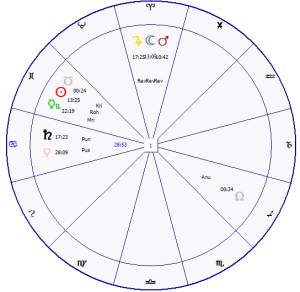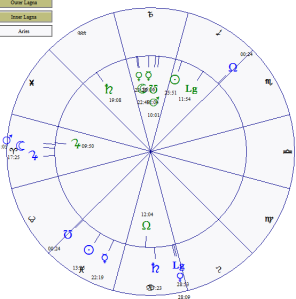These are the study notes from the first class in my new course on how to do relationship astrology. You can see more about the course and enroll here.
The Basic Idea
If you take one person’s astrological chart and compare it to another person’s, you should be able to tell how well they get along. The relationship between the planets in Chart A and the planets in Chart B should mirror the nature of the relationship between Person A and Person B.
Charts Together
It should go without saying, then, that all forms of relationship astrology require two horoscopes – one from Person A and another from Person B. Usually, the astrologer melds the two charts into a single composite chart – with Person A’s planetary positions represented on, say, the inside of a circle and Person B’s represented on the outside (circular charts are advantageous for this). This makes it much easier to see the relationships between the planets in both charts.
Here’s an example:
|
Angelina Jolie’s Circular Chart |
 |
|
Brad Pitt’s Circular Chart |
 |
|
Angelina & Brad Composite (Her planets are on the outside, in blue, his on the inside, in green) |
 |
Charts Apart
Although relationship astrology tends to jump right into interpreting the composite chart, and that is going to be exactly what we cover in this course, you should reserve a spot in your mind for looking at the charts separate from one another – and you should do it before you look at the composite.
Look at the individual charts to know how to skew / weigh your interpretation of the composite:
If you look at Person A and see a very relationship-oriented chart of a very cooperative person with a lovely seventh house and Venus, you know that person’s relationships are prone to be good – so put a more optimistic slant on your interpretation of whatever composite chart that person is involved in. If another person has a very independent nature to their chart with difficulties to Venus and the seventh house, that person is more prone to have difficult relationships – so you have to have a more pessimistic view of whatever composite chart that person is involved in.
Another reason to look at A and B individually is to see if they can fit together. If Person A’s chart is quite challenging for relationships, and Person B’s is quite blessed for relationships the two don’t “match” – you have to skew your interpretation of the composite chart to be less optimistic. If, on the other hand, Person A and B both have similar indications for challenges or blessings, the two do match – skew your interpretation of the composite to be more optimistic. Similarly, if Person A’s chart says she marries a religious man from another country, and Person B is from her hometown and very mundane in terms of spirituality and religion – you can’t be optimistic with the composite chart. That’s just an example, you should get the basic idea: If Person A and Person B individually have charts that seem to say the same things about relationships and seem to fit together, give a more optimistic reading to the composite. If not, be more pessimistic about it.
Two Schools of Interpretation
To my knowledge, there are two prominent schools of relationship astrology, one mostly tropical and “western” and the other mostly sidereal and “Indian.” There is no reason not to use both. We will learn both in this course.
The tropical system (We’ll just call it that, it’s not an official or perfectly accurate term) is based on the angular and zodiac relationships between the planets in the composite chart. The sidereal system (again, just our term) is pretty much based on the same thing, but in terms of the nakṣatras and without so much emphasis on geometric angles. Both systems are really very rich, and accuracy – for whatever reason – seems relatively easy to attain, compared to most other tasks the astrologer faces.
You Need Some Background Knowledge
It helps to be somewhat familiar with whatever topic you are investigating astrologically. Like, if you are doing stock-market astrology – besides whatever astrological techniques and principles you’ve mastered it’s pretty helpful if you understand what “stocks” are and how trading works and all that. Similarly, to be really good with relationship astrology, it’s important to understand human relationship, the emotional nature of the male and female genders, and so on. Learning the principles of astrology, especially relationship astrology will help you get and improve that background knowledge, but you’ll always vastly benefit your practice of relationship astrology by learning more and more about the nature of relationships – from any good source.
What You Can and Can’t Tell
Love is freewill.
Love is the conscious decision to bring happiness to someone else. It’s not always an intellectual or logical choice, it’s usually a very deep emotional choice that happens without calculation – but it’s always freewill. Love is the will to please someone.
Since love is freewill, astrology really can’t tell how much two people will love each other. But it can tell you how easy it will be for two people to love each other, or how much of a challenge it will be. And for most people knowing how easy or difficult it would be for them to love one another is practically the same thing as knowing how much they will love one another (since the majority of humanity is fairly asleep and on “auto-pilot” as far as karma and freewill go).
But you shouldn’t forget or fail to communicate that what you are reading when you read compatibility is the soil, not the seed. The gardener has the choice to throw a seed or not throw it. You can’t predict that. But you can, knowing the quality of the soil, predict that if she plants a see here – it will be healthy, or sickly, or whatever, unless she takes extra care of it, etc. So, that’s what relationship astrology will tell you – the conditions of the “soil” in which a couple can plant the seed of love.
Non-Romantic Relationships
Relationship astrology doesn’t have to be limited to marital / romantic compatibility, but the vast majority of times, it is. Reflecting that practical reality, we will mostly concentrate on marital / romantic relationship compatibility – and make only a few mentions of how to apply the same techniques to other sorts of compatibility situations.
These are the study notes from the first class in my new course on how to do relationship astrology. You can see more about the course and enroll here.
You must be logged in to post a comment.